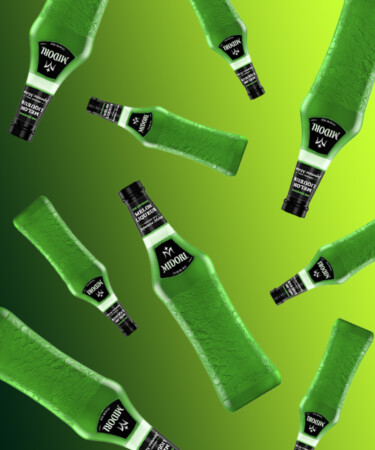With its vibrant, neon green hue, it’s no wonder Midori dominated in bars and nightclubs in the 1980s, when brilliantly colored cocktails were all the rage. Upon its release stateside in 1978, the Japanese melon liqueur — originally named Hermes Melon Liqueur — soared in popularity before falling out of bartenders’ favor once more distinguished cocktail programs gained traction. Today, Midori is slowly creeping back onto cocktail menus thanks to a newer, less sweet recipe landing on the market in 2013 and a resurgence of the same vibrantly colored cocktail trends that made Midori a hit in the ‘80s. Now that you know the basics, here are six more things you should know about Midori, the original melon liqueur.
The name ‘Midori’ literally means green.
When encountering a bottle of Midori, the first thing you’re likely to notice is the liqueur’s electric green color. Though originally dubbed Hermes Melon Liqueur, the beverage’s name was changed to Midori in 1978, which, when translated from Japanese, simply means “green.”
It’s made from two types of melon exclusively harvested in Japan.
Midori Melon Liqueur is made from Japanese musk and Yubari melons, both of which are sourced from Japan only. Yubari melons, which are harvested from Yubari City, are high in flavor and nutritional value due to the nutrient-dense volcanic soil, while muskmelons are native to the Aichi and Shizuoka provinces and are known for their rarity and luscious flavor. Muskmelons, growing only in these regions of Japan, are incredibly rare and can sell for up to $20,000.
No, it isn’t naturally green.
The process of making Midori begins with Yubari melons, which are harvested every June and July. Once the melons — which resemble cantaloupes — are harvested, they are broken down into a pulp, which is then immediately frozen before being sent off to Suntory. Suntory then defrosts the melon pulp and produces both a Yubari infusion and distillate, both of which are produced using neutral spirits. The Yubari infusions and distillates, like the Yubari melon itself, are orange in color. Both Yubari products are then blended with a muskmelon infusion and distilled to 59 percent ABV. At this point the distillate, which is now nearly clear in color with just a slightly orange tone, is packaged and sent out to Midori’s production facilities where the distillation process is completed and the liqueur is artificially colored green.
John Travolta was one of the first people to try the liqueur.
When Midori was launched in the United States in 1978, the liqueur debuted at the cast party for “Saturday Night Fever,” which aptly took place at New York’s former disco club Studio 54. Among the partygoers was John Travolta, who stars as Tony Manero in the iconic ‘70s film. On the night of its launch, the star-studded cast imbibed highlighter-green cocktails called “Japanese Gin & Tonics,” which featured one part gin, one- half part Midori, and tonic water.
Midori’s recipe was altered in 2012 to reduce artificial flavorings.
Midori may have never disappeared fully from the market, but due to its intense color and saccharine profile, it fell out of favor among consumers when more “serious” cocktail programs developed in the late ‘80s and ‘90s. In order to revitalize the melon liqueur, Suntory developed an updated recipe of Midori in 2012 that reduced the amount of artificial additives by 20 percent with the intention of making the drink less sweet and thus more enjoyable to the modern drinker. At this time, Midori’s packaging was also updated with a slimmer bottle featuring a holographic glass etching.
Glow sticks were an essential part of Midori’s rebranding efforts.
Midori was reintroduced to the public in its new form in 2013 at Tales of the Cocktail where the liqueur was used in Midori Highballs, each of which was garnished with a glow stick. Since its re-release, Midori has experienced somewhat of a revival, with bartenders all over the world featuring the liqueur in cocktails thanks to its eye-catching color and newer, lower-sugar recipe.
